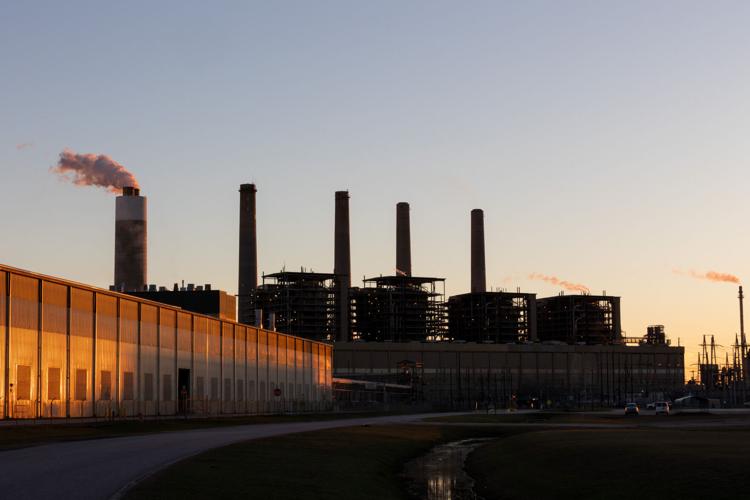Santee Cooperâs goal is to decrease carbon emissions by 50% from 2005 levels in the next decade and a half.
To do so, the state-owned utility will need to change how it produces its energy.
According to Santee Cooper documents, 52% of its total energy generation came from coal in 2022.
âIâm an absolute fan of renewable resources, but Iâm also a utility head and my job is to ensure that I can deliver the needs of the people of South Carolina at any given moment,â Santee Cooper CEO Jimmy Staton said. âIf that moment happens to be at 6 oâclock in the morning â which it normally is for us between 6 and 8 oâclock in the morning â on a cold winter day, Iâve got to have the resources to be able to serve that load. And at that point in time, solar isnât available.â
Some utility companies have set goals to reach carbon neutrality by certain dates. Duke Energy has announced a goal to reach net zero by 2050. Dominion Energy has done the same. Santee Cooper has not done so yet.
âSantee Cooper, weâve been a little reluctant to commit to an absolute date, and the reason for that is thereâs no magic bullet,â Staton said. âWe need technology to continue to advance.â
The utility has set a more lenient goal, though â to reduce emissions by 50% from 2005 levels by 2040. Emissions peaked in 2005 with 23 million tons of CO2.
Conor Harrison, an associate professor of geography at the University of South Carolina researching how power companies are shifting toward fossil fuels, is almost done writing a book on the topic. Harrison said that Santee Cooperâs energy portfolio is more coal-concentrated than the national average.
âWhen I look at this mix compared to national averages, thatâs almost twice as much coal,â Harrison said. âI would look at it and say itâs coal heavy and renewable light.â
Nationally, renewable energy usage has surpassed coal by 3% according to the U.S. Energy Information Administration.
Coal fired power plants are the biggest offender when it comes to emissions. According to the U.S. Energy Information Administration, 2.3 pounds of CO2 are emitted per kilowatt-hour of energy produced in the U.S. The only source with a higher emission per kWh is oil, which emits 2.4 pounds per kWh but is much less commonly used by power companies.

Santee Cooper, the state-owned utility company which powers Horry County, the Grand Strand and Moncks Corner, emitted more than 15 million metric tons of carbon dioxide in 2022. Photo by S.T. Cardinal/tommy.cardinal@myhorrynews.com
âCoal and natural gas both have a lot of carbon emissions associated with them both from CO2 and things like methane,â Harrison said. âThereâs also the problem of particulate emissions from coal plants that get in your lungs and are bad for you.â
CO2 is a greenhouse gas, meaning when it is released into the atmosphere, it traps heat that would normally be released back into space. Since the widespread adoption of the burning of fossil fuels, the Earthâs average temperature has increased about 2 degrees. that nearly all independently confirmed climate experts that were surveyed (99%) agree that humans are the driving force behind the warming climate.
In 2022, Santee Cooper emitted about 15.2 million metric tons of CO2 â 96,000 less than in 2021.
Staton said that Santee Cooper wants to decrease emissions and the utility has begun to move in that direction. The utility has seen a downward trend in emissions since 2005.

The Winyah Bay Generating Station in Georgetown has four steam turbines. Opened in four phases, the first unit of the plant debuted in 1975 and the last in 1981.Â
Those numbers are likely to continue decreasing especially with the upcoming closure of the Winyah Bay Generating Station in Georgetown. Originally, the first units were scheduled to shut down in 2023, then 2029. Staton said the Winyah location will now likely close in 2030, 2031 or later.
âThe original intent for us was to close Winyah in 2029. The growth in the state, however, has made us rethink that,â Staton said. âAnd so our plan now would be probably to close it more in the 2031 timeframe, but we made it very clear if growth continues to accelerate, we may have to delay that unless we can get other resources to replace it.â
The utility produced about 19,000 gigawatt-hours of energy in 2022, providing energy to about 205,000 retail customers. Santee Cooper disburses more energy than it produces, with about 30% of its total energy portfolio coming from purchases. Santee Cooper CEO Jimmy Staton said the source of that purchased energy varies, but that itâs often sourced from coal or natural gas.
Filling the gap
When Winyah closes, Santee Cooper will need to have added other power sources to fill the gap for a growing customer base.
Staton said the utility would like to âclose coalâ and that âIf I had my druthers,â Santee Cooper would enact a 33% nuclear, 33% renewables and 33% natural gas energy portfolio.

The Landrace Solar Facility near Bucksport on Highway 701 spans about 50 acres and is owned by Santee Cooper. Photo by S.T. Cardinal/tommy.cardinal@myhorrynews.com
Santee Cooper published in its 2023 integrated resource plan its âpreferred portfolioâ objectives, which includes retiring Winyah, installing more ways of generating solar energy (1,200 MW of solar from 2026 through 2029, 1,850 MW of solar from 2030-2040, installing 400 MW of battery storage from 2029-2040 and adding a 1,360 MW natural gas plant in 2031).
Staton said that Santee Cooper is aiming to create a âglide pathâ toward carbon neutrality using natural gas as a bridge and to ensure that the utility can supply power reliably. He said that âsolar alone wonât do it.â
New natural gas plants would be done in the hopes that they could be converted to hydrogen fuel if and when technological advancements allow, Staton said.
Burning hydrogen fuel is an environmentally friendly alternative to fossil fuels as doing so does not emit greenhouse gasses.
Harrison said the possibility of hydrogen fuel being used on a large scale is on the horizon but technologically is not entirely there yet.
âThatâs the next big thing according to a lot of entities out there,â Harrison said. âYou can [potentially] create hydrogen fuel that can then mimic other liquid or solid fuels and it can kind of be moved around and be used when you want it to as opposed to wind or solar which can only be used when [wind or sun] happens.â
The transition to green energy is moving too slowly in the energy sector, Harrison says, and heâs worried about the possibility of new fossil fuel infrastructure being installed in place of an old fossil fuel power plant.
âThe expectation when utilities build power plants is that theyâre going to be around for a long time,â Harrison said. âThatâs why I start to get a little uncomfortable when utilities talk about building new gas plants as a bridge to get us to a point with more renewables because itâs not just building a new gas plant for another five or 10 years. Their expectation is that theyâre going to be building a new gas plant thatâs going to last for 40 to 50 years.
âThese decisions that are being made now about what sort of generation we should be adding to the grid arenât going to impact us just for a few years. Theyâll impact us for a long time.â
Power plants also take many years to be built. According to Santee Cooperâs 2008 annual report, the Cross Generating Station took 25 years to complete.
Thereâs also the case of the VC Summer nuclear plant expansion which fell through completely after Santee Cooper, a minority owner of the facility with Dominion Energy, borrowed billions to pay for the construction of VC Summer Units 2 and 3.
âYou canât talk about nuclear in South Carolina without talking about the VC Summer plant. Thatâs sort of cast a shadow over every conversation,â Harrison said. âThe big plants are pretty much out of the picture just based on our seemingly inability to do them.â
Staton said in order to transition to an energy portfolio with renewables like solar, technology needs to progress.
âYouâve got to pair it with battery storage. Thatâs incredibly expensive right now. You may see prices come down, but there are some technical issues that are still concerning. Itâs lithium ion batteries. Thereâs a reason you canât put lithium ion batteries in the storage compartment of airplanes because they might catch fire,â Staton said. âThe same thing holds true to batteries right now â they may catch fire and you canât put them out. They just have to burn. I think that technology will develop, but that technology is not there yet. So itâs not as easy as just saying build as much solar as you possibly can. Without a flexible resource like a natural gas plant, I can only accommodate so much solar.â
Good news for solar power is that the price is now cheaper than coal, Harrison said. That number comes from something called the levelized cost of energy which takes many factors including installation cost, fuel and maintenance into account to determine which energy source gives you the most bang for your buck.
Nuclear energy makes up 11% of Santee Cooperâs energy portfolio right now and is the third slice of Statonâs preferred future energy portfolio pie.
But Staton said that the utility is not planning on constructing any additional nuclear plants unless small modular reactors, a technology still under development, progresses further.
S.C. Gov. Henry McMaster said small modular reactors are an exciting possibility for the future of energy in South Carolina.
âI think everyone would like to see that weâre as clean as possible. Nuclear energy is right at the top of that list because itâs 100% clean, it works 24 hours a day, it produces much, much power, so we are happy to see the advent of small modular reactors seems to be moving forward well because thatâs a big part,â McMaster told MyHorryĖĮÐÄvlogđŲ·―ČëŋÚ. âI donât know if weâll be building around the nation into these huge reactors, or not as many as we have before.â
The big question in regard to small modular reactors, Harrison said, is who is going to take the initial financial risk of installing a new technology.
âI think whatâs tricky is knowing which [prototype] is going to be the winning design,â Harrison said. âI attend a lot of industry conferences and events just to see what theyâre talking about and the sort of sense that Iâve gotten around small modular reactors is that thereâs a lot of utilities that wouldnât mind being the fifth or sixth order to a manufacturer of those, but nobody wants to be the first.â
Staton said small modular reactors are a very important and needed advancement for Santee Cooper to reach net zero emissions.
âIf SMR becomes a technology that is easily adaptable, I could see [net zero] happening by the 2050-ish timeframe, but Iâm not ready yet and our board hasnât determined that we have a hard date in mind,â Staton said. âBut what our plan is, let's reduce emissions steadily, keep it affordable and reliable and letâs let technology continue to develop.â
Harrison said he is hopeful that technology will progress to allow power companies to provide energy with very low or no emissions, but that it needs to happen quicker.
âI think if youâre concerned about climate change, which I am, itâs happening too slowly,â Harrison said. âTo try to transition the system to limit our carbon emissions to try and keep the increase in temperatures lower than what itâs projected to be is crucially important especially with coastal communities.â









(0) comments
Welcome to the discussion.
Log In
Keep it Clean. Please avoid obscene, vulgar, lewd, racist or sexually-oriented language.
PLEASE TURN OFF YOUR CAPS LOCK.
Don't Threaten. Threats of harming another person will not be tolerated.
Be Truthful. Don't knowingly lie about anyone or anything.
Be Nice. No racism, sexism or any sort of -ism that is degrading to another person.
Be Proactive. Use the 'Report' link on each comment to let us know of abusive posts.
Share with Us. We'd love to hear eyewitness accounts, the history behind an article.